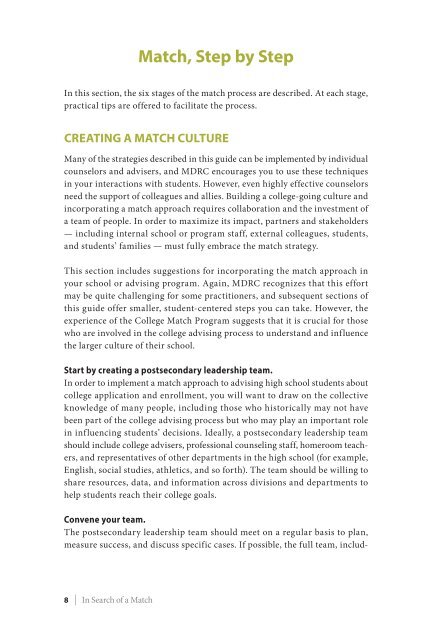In Search of a Match
MOeAyZ
MOeAyZ
You also want an ePaper? Increase the reach of your titles
YUMPU automatically turns print PDFs into web optimized ePapers that Google loves.
<strong>Match</strong>, Step by Step<br />
<strong>In</strong> this section, the six stages <strong>of</strong> the match process are described. At each stage,<br />
practical tips are <strong>of</strong>fered to facilitate the process.<br />
Creating a <strong>Match</strong> Culture<br />
Many <strong>of</strong> the strategies described in this guide can be implemented by individual<br />
counselors and advisers, and MDRC encourages you to use these techniques<br />
in your interactions with students. However, even highly effective counselors<br />
need the support <strong>of</strong> colleagues and allies. Building a college-going culture and<br />
incorporating a match approach requires collaboration and the investment <strong>of</strong><br />
a team <strong>of</strong> people. <strong>In</strong> order to maximize its impact, partners and stakeholders<br />
— including internal school or program staff, external colleagues, students,<br />
and students’ families — must fully embrace the match strategy.<br />
This section includes suggestions for incorporating the match approach in<br />
your school or advising program. Again, MDRC recognizes that this effort<br />
may be quite challenging for some practitioners, and subsequent sections <strong>of</strong><br />
this guide <strong>of</strong>fer smaller, student-centered steps you can take. However, the<br />
experience <strong>of</strong> the College <strong>Match</strong> Program suggests that it is crucial for those<br />
who are involved in the college advising process to understand and influence<br />
the larger culture <strong>of</strong> their school.<br />
Start by creating a postsecondary leadership team.<br />
<strong>In</strong> order to implement a match approach to advising high school students about<br />
college application and enrollment, you will want to draw on the collective<br />
knowledge <strong>of</strong> many people, including those who historically may not have<br />
been part <strong>of</strong> the college advising process but who may play an important role<br />
in influencing students’ decisions. Ideally, a postsecondary leadership team<br />
should include college advisers, pr<strong>of</strong>essional counseling staff, homeroom teachers,<br />
and representatives <strong>of</strong> other departments in the high school (for example,<br />
English, social studies, athletics, and so forth). The team should be willing to<br />
share resources, data, and information across divisions and departments to<br />
help students reach their college goals.<br />
Convene your team.<br />
The postsecondary leadership team should meet on a regular basis to plan,<br />
measure success, and discuss specific cases. If possible, the full team, includ-<br />
8 | <strong>In</strong> <strong>Search</strong> <strong>of</strong> a <strong>Match</strong>



